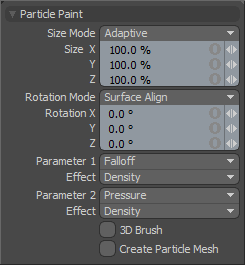Much like MODO's painting tool allow users to apply color onto a surface, the 'Particle Paint' tool allows users to spray particles onto a surface in an intuitive and controllable manner. Particles are simply single vertices that can be used to control a number of other functions in MODO, such as point sources for goemetry Replicators, and the Texture Replicator, as well as point clouds for Blobs, Volumes and Sprites. Once the particles have been created, users can continue editing them by using the Particle Paint tools; combined with their 'Particle Constraint' option, users are afforded ultimate control over the placement of the individual particles. Of course the generated Particles can also take advantage of all the additional controls available with Particle Vertex Maps, such as the Transform Map, providing extensive controls for the most demanding applications.
Using the Tool
The Particle Paint Tool is found in the 'Paint' interface tab, under the 'Particle Tools' subtab of it's toolbox. Particles will only spray onto polygon surfaces, so users will need to select the appropriate target layer to spray onto prior to activating the tool. Upon selecting the tool, its attributes appear in the tool properties viewport. When first selected, the tool will also automatically select the Brush Tip, by default the 'Smooth Brush'. Users can select one of the alternate Brush Tips before proceeding or RMB+click in the 3D viewport to interactively scale the brush size. Users can then simply LMB+click and drag in the viewport to start creating particles. Addition control is added by applying the 'Parameter 1 & 2' options.
Particle Paint--
 Size Mode: When creating the Particles, a 'Particle Size' Vertex Map can is generated automatically, storing additional information that can be used to control the scaling of the eventual clones or volume elements. The results of the scaling are dependant on the following settings-
Size Mode: When creating the Particles, a 'Particle Size' Vertex Map can is generated automatically, storing additional information that can be used to control the scaling of the eventual clones or volume elements. The results of the scaling are dependant on the following settings-
Uniform-- The 'Uniform' option results in identically sized elements, controlled by the 'Size X,Y & Z' setting values.
Adaptive-- The 'Adaptive' option will scale elements larger or smaller based on the size of the Brush Tip used.
Random-- The 'Random' option will randomly scale the elements up to the maximum scaling amount, determined by the 'Scale X, Y & Z' values.
Adaptive+Random-- The 'Adaptive+Random' option will randomly scale the elements in relation to the size of the Brush Tip, with the maximum scaling amount determined by the 'Scale X,Y &Z' values.
Rotation Mode: When creating the Particles, a 'Particle Transform' Vertex Map can is generated automatically, storing additional information that can be used to control the rotation of the eventual cloned or volume elements. The results of the rotation are dependant on the following settings-
Uniform-- The 'Uniform' option results in identically oriented elements, controlled by the 'Rotation X,Y & Z' setting values.
Surface Align-- The 'Surface Align' option results in elements that are oriented to align with the surface polygons normal direction.
Random-- The 'Random' option results in randomized rotations for each element, up to the maximum rotation amount determined by the 'Rotation X,Y &Z' setting values.
Surface Align+Random-- The 'Surface Align+Random' first orients the element to the surfaces normal direction, and then offsets it with an additional random rotation up to the maximum amount determined by the 'Rotation X,Y &Z' setting values.
Surface Align+Tablet-- The 'Surface Align+Tablet' first orients the element to the surfaces normal direction, and then offsets it based on the angle of a pen on a tablet.
Surface Align+Tablet (No Pitch)-- The 'Surface Align+Tablet' first orients the element to the surfaces normal direction ignoring the sloping angle (pitch), and then offsets it based on the angle of a pen on a tablet
Screen Align+Tablet-- Description coming.
Screen Align+Tablet (No Pitch)-- Description coming.
Parameter 1/2: The 'Parameter' options provider users with two additional controls in creating particles. It is a two-step process. First the controlling input is defined as the 'Parameter' option, and the result of that control is defined as the 'Effect'. Both options are in combination with the 'Brush Tip' input. Some options relate to using a Pen and Tablet input combination to control elements.
Falloff-- The 'Falloff' option allows MODO's many 'Falloffs' to be used to determine the 'Effect'. Since the Brush Size action superseded the falloff set with the RMB< make sure to define the falloff prior to activating the tool.
Pressure-- The 'Pressure' of input related to how hard the pen is pressed against the tablets surface controls the 'Effect'.
Slope-- The downward 'Slope' of the target polygon surface controls the 'Effect'.
Altitude--
1.0 Slope--
1.0 Altitude--
Effect: The 'Effect' is simply the results that is controlled by the chosen 'Parameter' input option.
(none)-- The 'None' option disabled the Parameter/Effect option.
Density-- The 'Density' option controls the number of sprayed particles as determines by the input 'Parameter' option.
Size-- The 'Size' option controls the scale of sprayed particles as determines by the input 'Parameter' option.
Rotation-- The 'Rotation' option controls the orientation of sprayed particles as determines by the input 'Parameter' option.
Size+Density-- The 'Size+Density' option controls the number and scale of sprayed particles as determined by the input 'Parameter' option.
3D Brush: When '3D Brush' is enabled, particels will be created within the 3D volume of the brush tip, adding depth to the particles, so they arent placed directly against the constraining background surface.
Create Particle Mesh: When the 'Create Particle Mesh' option is enabled, an additional 'Mesh' item layer is created containing all the particles as a child item of the target layer. This eliminates the need to copy and paste the vertices into a new mesh layer manually when used as a Point Source.


